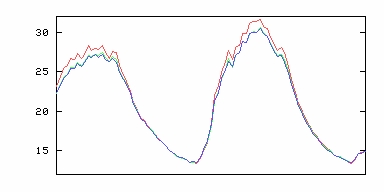Collection and Analysis
of Earth-Based Temperature Data

Objective: to analyze self-collected temperature
profile data that is similar to the data collected by the Mars Pathfinder
lander.
Procedure
- Prepare a device that will read the temperature at the prescribed heights.
- Use meter sticks and thermometers. Attach the thermometers with tape
at 0.25 meters, 0.50 meters, and 1.00 meters above the ground or use one
thermometer and hold it at the various heights.
- Make a meteorological mast.
- Create a data table. Include where you are collecting the data (the
surroundings), the type of surface over which you are collecting data,
the date, time, and conditions (cloud cover, precipitation, wind).
- Take your meteorological mast outside and choose a site to collect
your data. Wait at least three minutes after setting up at your site before
recording the temperature. Your thermometer needs to adjust to the outside
temperature.
- Record conditions and temperature profiles at various locations. Consider
time of day, shading, season, how thermometers are handled, etc. in your
data collection.
- Collect temperature data for at least six hours in at least one location.
Remember to record as accurately as possible!
Graph the data you collected.
- Make the horizontal axis represent time in even units (such as hours).
- Make the vertical axis represent temperature in even units (such as
degrees Celsius).
- Plot the temperatures of all three heights on the same graph using
a different color for each height.
- Label the graph and axes.
Questions to consider (Use your graph to answer the questions)
- What about the graph helps you distinguish between night and day?
- Does the temperature change at the same rate each morning?
- Is the rate of increase the same as the rate of decrease over a day?
- Describe the temperature profile for the warmest part of a day.
- Describe the temperature profile for the coldest part of a day.
- Are the temperature profiles for warmest and coldest parts of a day
the same?
- Is the temperature profile for the warmest part of a day the same for
all days?
- Answer only if you have completed Download
and Analysis of Mars-Based Temperature Data --Is the change you
described in the previous question the same for temperatures on Mars?
- What factors might affect your temperature readings?
- If you were to do this experiment again, what would you do differently?
Conduct one or more of your new experiments. Describe the results you
collected below. What can you conclude about the new test results you collected?
Does it change any of your first conclusions you made? Why or why not?
© 1998 Live
from Earth and Mars, Janice DeCosmo, Rich Edgerton, and Janet Charnley

